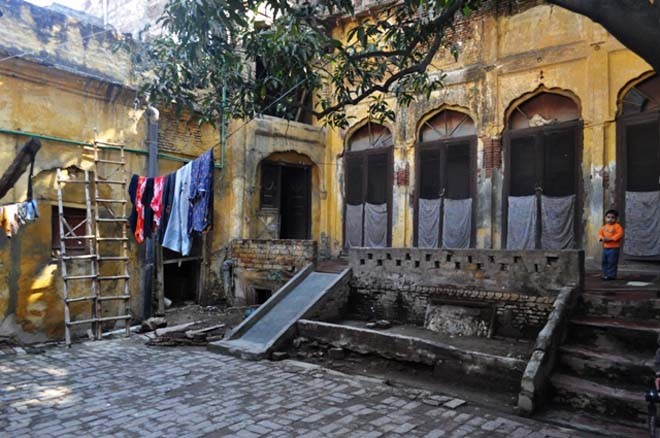
Haveli Dina Nath speaks volumes of its majestic past but its present state needs the attention of the authorities

Passing through the Phoolon Wali Gali, near Wazir Khan Mosque, inside the Walled City of Lahore, I saw a plaque briefly outlining the history of Haveli Dina Nath. It was an interesting fact sheet that reads, "The haveli is named after a Hindu Raja, Dina Nath, who was a courtier during Ranjit Singh’s reign. The total area of the Haveli is 47 marla, with 19 rooms and two basements including verandas and an open space backyard. An underground tunnel and basements also exist here."
The charm of basements and tunnels led me into the haveli. Going ahead through a narrow pitch dark staircase, I knocked at an antiquated, carved wooden door. The growling of the dog inside the haveli cautioned the residents about a new comer. An old lady opened the door and asked me if I wanted to visit the haveli.
The haveli was probably a declared tourist site and the residents were accustomed to entertaining the visitors. This was a new thing for me, given the current security situation in the country. But such hospitality and confidence could only be found inside the Walled City.
The lady, Mrs Khawar, had been living at the place since long. According to her, Haveli Dina Nath was transferred to her father-in-law Khursheed Sahib after partition. At that time, five families lived in the haveli. Three of them moved out to other parts of Lahore.
The haveli was mesmerizing. What a marvel of architecture!
The yellow painted structure of the haveli, its huge platform and basins of fountain, were typical of Sikh architecture, with arches, balconies, carvings, fresco work, worship places and the secret staircase to mezzanine floors.
Sikh architecture, evolved almost 300 years ago, is a blend of sophistication, ascetic beauty and elegant lines which reflected strongly in this haveli.
I was told that the ancestors of the dwellers had found many antiques and record books in the lockers and cabinets found in the mezzanine and basements, which were either sold or given away by the family.
They must be ignorant of the value of those things, I thought.
Mrs Khawar escorted me to all the rooms of the haveli, as half of the family was still asleep. It was Sunday, after all.
I was shocked to see the costly interior and remains of fresco work on the ceilings of almost every room. A huge drawing room, with mirror work on the ceiling, connected the main hall with small rooms. The lady took me to a room and, to my surprise, a small opening in the wall led to the mezzanine floor.
I asked her if I could see the basements and tunnels. She happily guided me to a basement, calling it a "sard khana (cold storage)." It was really cold in there.
The basement walls had small, inbuilt arches and a prayer room in one corner. On one side of the basement there was a sealed staircase. That was the tunnel I was wondering about. Yes, it was there.
Noticing my curiosity, the lady told me that it had been blocked many years ago by her husband for the fear that it would lead to the borders.
It was one amazing experience. Capturing memories in my camera, I thanked the generous lady and left.
After the visit, I was inquisitive about Dina Nath who built this stunning haveli. Through some research, I got to know that Raja Dina Nath, or Diwan Dina Nath, belonged to a Kashmiri Pandit family living in 17th-century Delhi. In 1815, Maharaja Ranjit Singh invited him to Lahore and offered the post of the writer in the department of military accounts. In 1826, after the demise of Diwan Ganga Ram, one of Ranjit Singh’s courtiers, Dina Nath succeeded him as the head of military accounts department and keeper of the privy seal, and in 1834 he became the head of the civil and finance office. Maharaja Ranjit Singh awarded the honorary title of Diwan to Dina Nath in 1838, which means the custodian of finances.
Haveli Dina Nath speaks volumes of its majestic past but its present state needs the attention of the authorities. The architectural marvel needs to be conserved and restored immediately before it is further damaged.